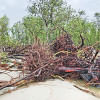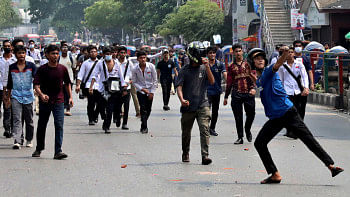The scars of the 1991 cyclone remain, so do the coastal communities' vulnerabilities

April 29, 2025, marks the 34th anniversary of the devastating super cyclone that struck the southeastern coast of Bangladesh in 1991. Also known as Gorky, it is recognised as one of the deadliest tropical cyclones in recorded history.
The storm originated in the Bay of Bengal, intensified, and made landfall near Chattogram with winds reaching up to 240 kmph. It caused a catastrophic storm surge of more than 20 feet high, inundating coastal areas and killing over 138,000 people.
The majority of the fatalities occurred in the southeastern coastal belt such as Banshkhali, Anowara, Chakaria, Pekua, and Moheskhali. In addition to the immense human toll, the cyclone left over 10 million people homeless. Overall property and infrastructure damage was in the billions of dollars.
Even after 34 years, coastal communities in southern Chattogram and Cox's Bazar continue to bear the haunting memories of the cyclone. It became a part of their history and collective memory. People still recall the horrifying experiences of that fateful night, especially when cyclone alerts are raised during the April-May period.
I was born and grew up in a climate-vulnerable coastal village in Banshkhali, one of the hardest-hit upazila. My mother is still haunted by the horrors of that awful night. She shares with us how the cyclone struck with a storm surge as high as a two-storied building, sweeping away everything in its path. She had never witnessed such an obliteration before. People in the village did not expect the cyclone to hit with such power, rising above the embankment and inundating the villages.
There was no internet and no mobile phones at that time. Radio was the main means of getting updates. People heard the cyclone warning and became alert, but they were not prepared for a dangerous storm surge that swept away their homes, trees and everything else that night.
The cyclone made landfall during high tide which made the situation worse. My mother was in our home with other family members. She remembers, in a matter of 10 minutes, she lost track of all family members as the sea water engulfed them and washed away everything. It was a scary night with intense storms and salty rain. People were trying to survive holding floating items such as roofs of bamboo-huts and big trees. My mother managed to hold onto a tree and took shelter on it for the whole night. As she clung to the tree, she saw people and livestock floating by.
When the water started receding in the early morning, she climbed down from the tree. Hungry and devastated, and with nothing but the clothes on her back, she cried and began searching for her family members like everyone else. Everything was flattened and there was water everywhere. She saw countless dead bodies lying face down. No road to follow, no house to go to—the night had changed everything. Some families in our villages were completely wiped out by the cyclone. People were buried in mass graves.
Even after all these years, whenever a cyclone alert is raised, my mother insists that I seek shelter in an elevated place. Despite the passage of time, the scars left by the cyclone are still fresh in the minds of the coastal people who survived. Over the years, the disaster risks in the coastal communities have increased due to global warming, sea level rise and denser human inhabitance along the coastlines. Little has been done to reduce the disaster risks and improve resilience, especially along the Banshkhali coastlines.
Bangladesh has 580 km long dynamic and diverse coastlines. Our coastal areas have always been highly populated due to their abundant natural resources. However, in this age of climate change, these regions by the Bay of Bengal remain highly susceptible to numerous natural hazards, including tropical cyclones accompanied by storm surges.
Recent reports indicate that the water in the Bay of Bengal is rising faster than the global average and it is known as a hotbed for tropical cyclones. According to research published by Jeff Masters, a hurricane scientist at Yale Climate Connections, 22 of the 30 deadliest tropical cyclones worldwide have occurred in the Bay of Bengal. A new study published on April 11 by researchers at the Massachusetts Institute of Technology (MIT), highlighted that the catastrophic cyclone, which was once a 100-year event in the Bay of Bengal, could now strike every 10 years—or even more often frequently. In the WorldRiskReport, published jointly by the Institute for International Law of Peace and Armed Conflict (IFHV) of the Ruhr-University Bochum and an alliance of nine German development organisations, Bündnis Entwicklung Hilft, Bangladesh is listed as a "very high risk" country, with a score of 27.73 out of 100. This places us among the top 10 most affected countries globally by extreme weather events.
Every year thousands of people are being displaced, losing livelihoods in the coastal areas due to various climate effects. In Banshkhali coastlines, since 2005, we have seen dramatic changes including powerful tidal flooding, breaching of embankments, uprooting of trees, erosion of coastal land, displacement of people, high salinity in the rice fields and so on. Many elderly people say they have not witnessed such turbulence in the bay's waters in the last 100 years. Furthermore, mangroves along the coastline have been erased for shrimp projects and salt-producing fields leaving people without adequate natural protection.
Banshkhali being an outlying upazila has often been overlooked and remained out of focus, particularly its western coastal villages. There are places with broken and poor embankments. Monsoon is approaching bringing with it worry and anxiety. In my village, there is just one cyclone shelter which was built in 1994 with funding from Saudi Arabia. Since then, the population of the village has doubled and vulnerability to cyclones has increased but cyclone shelter number has not increased, remaining insufficient. This is the case in most of the coastal villages in Banshkhali.
Every year, cyclones strike us with devasting effects reminding us of the need to build more coastal resilience. While traditional hard solutions are necessary in many areas, nature-based solutions such as salt marshes and mangroves also significantly help by building up and protecting coastlines from tidal surges and erosion.
Living along the Bay of Bengal in this era of escalating climate effects requires special climate awareness, adaptation measures and improved disaster preparedness. Youth and social organisations' engagement in tackling climate change on our coastlines should be prioritised.
Parvez Uddin Chowdhury is a development worker and climate enthusiast. He can be reached at [email protected].
Views expressed in this article are the author's own.
Follow The Daily Star Opinion on Facebook for the latest opinions, commentaries, and analyses by experts and professionals. To contribute your article or letter to The Daily Star Opinion, see our submission guidelines.

 For all latest news, follow The Daily Star's Google News channel.
For all latest news, follow The Daily Star's Google News channel. 









Comments